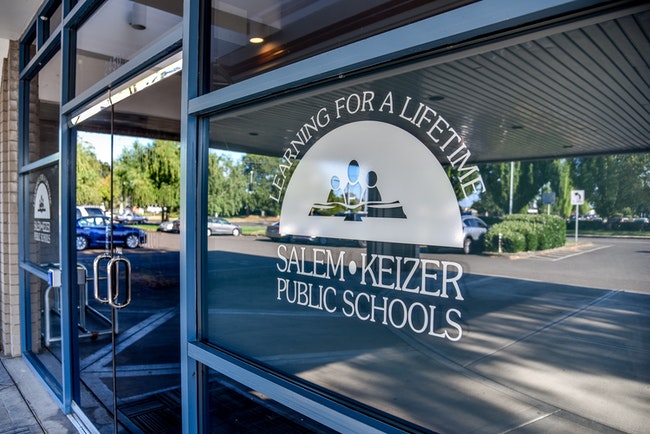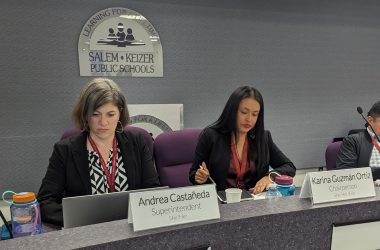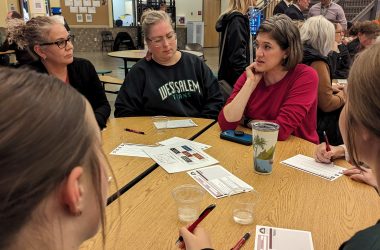
Reuben Gershin’s breaking point was in early October, when his son tried to pry him from his work so the two could spend time together.
“But dad, it’s Saturday,” the kindergartener said.
Gershin, a high school science teacher in the Salem-Keizer School District’s online EDGE program, said he and his colleagues have had to work four to six hours Saturdays and Sundays just to keep up with lesson planning, grading and communicating with parents.
While teachers routinely work outside the hours they’re paid for, he said he’s never come close to a schedule like this in his 14 years teaching.
“This year is so much more than it ever has been,” he said.
Many of the demands, he said, come from scheduling changes district leaders made at the start of the school year which required teachers to retool lesson plans for a new schedule and simultaneously teach live classes while being responsible for students studying course material independently.
“It’s getting to the point where it’s not physically tenable anymore,” Gershin said in a December interview.
After months of bargaining, district leaders earlier this month reached an agreement with the Salem-Keizer Education Association to cut back class hours and give EDGE teachers more prep time.
The agreement, signed Jan. 13, means EDGE middle and high school students no longer have live classes on Wednesdays. Instead, teachers have much of the day to plan, prepare, grade and communicate with students and families.
“We’re really happy with the outcome. It took a long time to get there,” said Tyler Scialo-Lakeburg, president of the Salem-Keizer Education Association.
District leaders created the EDGE program for the 2020-21 school year amid uncertainty about how classes would be held in the midst of a pandemic. The acronym stands for “Enhanced Guided and Digital Instruction.”
The program was intended to be an online school option for families and educators who knew they wanted to remain remote all school year, regardless of how the Covid situation unfolded. But district leaders said they would keep EDGE around as an option for families and students who preferred online instruction.
This school year, about 500 middle school and 475 high school students are enrolled in EDGE.
For the 2021-22 school year, administrators made several changes to the program.
Classes were switched from quarters to trimesters for high school students. That was based on feedback from families with multiple students enrolled in the program who wanted them on the same schedule, EDGE co-principal Christine Bowlby said.
Students were also given the option to enroll as “independent” students, meaning they weren’t required to attend live classes and would turn in work at their own pace.
Elementary students working independently had their own teachers assigned to supervise their progress and help with work as needed. But middle and high school teachers in EDGE were assigned mixed classes – a majority enrolled for live instruction, with some working independently.
The goal was to reduce the number of classes teachers had to prepare for since lesson plans could be used for both groups of students, and to allow independent students the option to drop in on live classes if they wanted, said Suzanne West, the district’s director of strategic initiatives.
Gershin said those changes created substantial extra work for teachers that became impossible to manage.
Teachers had to adapt lesson plans that were developed for semester-long classes taught on a block schedule with little notice, he said.
That meant shifting from teaching two 90-minute periods and one shorter lesson per week to five 50-minute lessons for each class. Instead of 18 weeks to cover a class worth of material, they only had 12.
Teacher prep time was also reduced, Gershin said, from one 90-minute block to a 50 minute period and a 20 minute period at different times during the day.
“I’m in triage mode, constantly in triage mode. I am not helping individual students – I am barely able to function for tomorrow’s class,” he said.
A union survey of EDGE teachers found they were working on average an extra 20 hours per week outside of the time they’re paid for, Scialo-Lakeberg said. Keeping up with lesson planning was the primary backlog.
Teachers also became responsible for proactively reaching out to and assisting their independent students without extra time in the day to do it, Gershin said.
“I have six students who never have to come in, who never have to be there, who never have to communicate with me, but I’m still responsible for reaching out,” he said.
Union leaders requested to bargain over teacher work schedules in mid-September.
The January agreement says the district will hire new teachers to oversee independent students, splitting that program from the live instruction program for middle and high school.
Five full-time positions are now open, said Aaron Harada, district spokesman.
EDGE teachers will be paid $3,000 in back pay for their work in the fall simultaneously covering live and independent students, and will receive $1,500 per trimester they continue to do so until enough teachers are hired for the programs to be split.
The agreement also calls for more non-class time, like grading and in-service days, to be used for teacher prep rather than meetings or other training.
Scialo-Lakeberg said the agreement has been a “life ring” for teachers who were burning out because of the extra hours. One member wrote her saying the change was “so healing for us which will extend immediately and directly to our students.”
Gershin, who was involved in negotiating the agreement, said he’s glad to see the changes, but remains frustrated that issues weren’t addressed promptly when teachers raised concerns in August and September.
“Never could I have imagined we would get concessions like that” from the district, he said in an email.
He’s now on medical leave to recover from stress and medical issues the high workload triggered, he said. He’s planning to take second trimester off and return in about six weeks.
“It is my hope that with these changes I will be able to return to finish out the year. I don’t know if these changes are enough to make it possible, but at least now it is in the realm of possibility,” he said in an email.
Contact reporter Rachel Alexander: [email protected] or 503-575-1241.
JUST THE FACTS, FOR SALEM – We report on your community with care and depth, fairness and accuracy. Get local news that matters to you. Subscribe to Salem Reporter starting at $5 a month. Click I want to subscribe!









